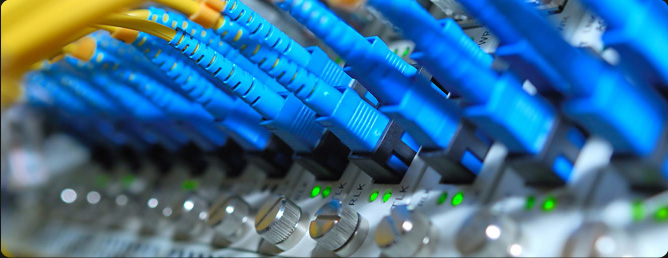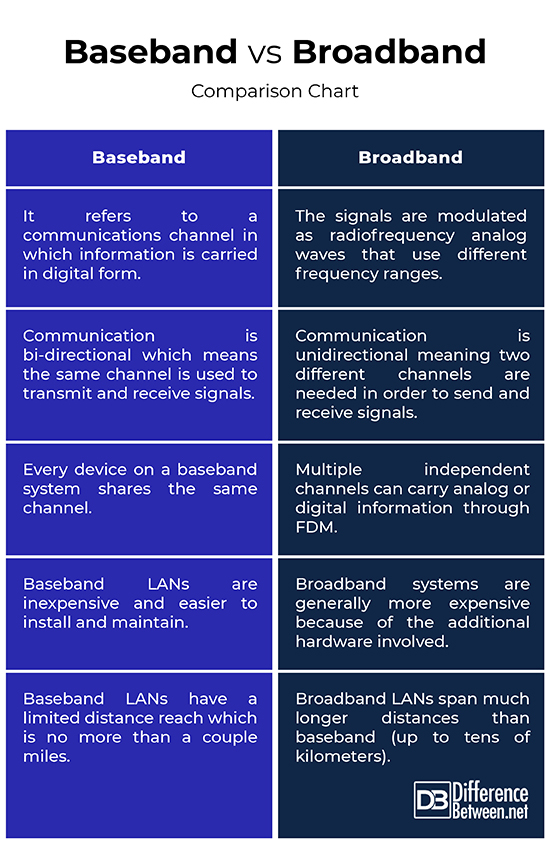Difference Between Baseband and Broadband
There are two transmission techniques used with local area networks depending on the type of signaling (digital or analog) used for the communication between two nodes – baseband and broadband. These are the two switching techniques defined over transmission media and distinguished by the type of signals used to multiplex transmissions from a multitude of stations onto a single transmission medium. Baseband is defined as transmission format that uses digital signaling and uses the transmission medium as a single-channel device. Broadband is defined as a transmission format in which signals are modulated as radiofrequency (RF) analog waves that use different frequency ranges. The decision to use baseband or broadband is determined by the application.

What is Baseband?
Baseband refers to a communications channel in which information is carried in digital form and which uses the transmission medium as a single-channel device. This means a single channel is used to communicate with devices on a network, which allows computers to transmit and receive data on a single cable. Only one station can transmit at a time, and all stations must transmit and receive the same types of signals. The communication is bi-directional meaning the same channel is used to transmit and receive signals. Every device on a baseband system shares the same channel. When one node transmits data on a baseband channel, all other nodes on the network have to wait for the transmission to end before they are able to transmit data. The only problem with baseband LANs is their limited capacity over a limited distance which is no more than a couple miles.

What is Broadband?
Broadband transmission is a digital electrical transmission in which signals are modulated as radiofrequency analog waves that use different frequency ranges. Unlike baseband, broadband technology does not encode information as digital pulses. It generates an analog carrier frequency, which carries multiple digital signals or multiple channels. Each channel occupies a different frequency band out of the total bandwidth allocated (frequency-division multiplexing). Consequently, each channel can contain different modulation and encoding schemes and operate at different transmission rates. Through FDM, multiple independent channels can carry analog or digital information, depending on the interfaces. This is essentially the way cable television operates. The cable TV connection can carry at least 25 times as much data as a typical baseband system can carry. Broadband systems are generally more expensive to install and maintain because of the additional hardware involved. However, they span much longer distances than baseband.
Difference between Baseband and Broadband
Technology
– A baseband transmission is a single, fixed signal that uses the entire available bandwidth and uses the transmission medium as a single-channel device meaning only one station can transmit at a time, and all stations must transmit and receive the same types of signals. A broadband transmission, on the other hand, is a digital electrical transmission in which signals are modulated as radiofrequency analog waves that use different frequency ranges. Each transmission is assigned a portion of the total allocated bandwidth, therefore, multiple transmissions can be possible at the same time.
Communication
– With baseband systems, communication is bi-directional which means the same channel is used to transmit and receive signals and each device shares the same channel. When one node transmits data, all the other nodes on the network must wait until the transmission ends before they can start sending data. Broadband communication, on the other hand, is unidirectional meaning two different channels are needed in order to send and receive signals – one for sending and the other for receiving. Through frequency division multiplexing (FDM), multiple independent channels can carry analog or digital information, depending on the interfaces.
Capacity
– Baseband implies a single-channel digital system and this single channel carries information in packets or frames specified by the LAN standard in use. Baseband LANs are inexpensive and less complicated. The shielded twisted-pair cable offers more capacity than the twisted-pair baseband, but it’s more expensive. The problem with baseband LANs is their limited capacity over a limited distance which is no more than a couple miles. Broadband, on the other hand, LANs span much longer distances than baseband but the broadband systems are generally more expensive because of the additional hardware involved.
Application
– The most common and the widely used baseband standard is Ethernet-based wired local area networks, which accounts for about 85% of the installed LAN base. In Ethernet, each device on a network can transmit over the wire, but only one device at a time. The best example of broadband transmission is the cable TV, which carries at least 25 times as much data as a typical baseband system carries. Other applications of broadband technology include radio and telecommunications, computer networks, Internet broadband, etc.
Baseband vs. Broadband: Comparison Chart

Summary of Baseband vs. Broadband
Baseband communications are typically used for local area networks because it is self-contained within a single location, where network traffic can be easily monitored and controlled. Baseband refers to a single-channel digital system and that single channel is used to communicate with devices on a network. Broadband, on the other hand, is wide bandwidth data transmission which generates an analog carrier frequency, which carries multiple digital signals or multiple channels. Broadband transmission formats use the connecting media as a multichannel device.
- Difference Between Caucus and Primary - June 18, 2024
- Difference Between PPO and POS - May 30, 2024
- Difference Between RFID and NFC - May 28, 2024
Search DifferenceBetween.net :
Leave a Response
References :
[0]Bidgoli, Hossein. The Internet Encyclopedia, Volume 2. Hoboken, New Jersey: John Wiley & Sons, 2004. Print
[1]Bidgoli, Hossein. The Internet Encyclopedia, Volume 2. Hoboken, New Jersey: John Wiley & Sons, 2004. Print
[2]Tomasi, Wayne. Electronic Communications System. Noida, India: Pearson Education India, 2001. Print
[3]Hura, Gurdeep S. and Mukesh Singhal. Data and Computer Communications: Networking and Internetworking. Boca Raton, Florida: CRC Press, 2001. Print
[4]Dean, Tamara. Network+ Guide to Networks. Boston, Massachusetts: Cengage Learning, 2009. Print
[5]Goleniewski, Lillian. Telecommunications Essentials. Boston, Massachusetts: Addison-Wesley, 2002. Print
[6]Image credit: https://commons.wikimedia.org/wiki/File:Broadband-internet-solutions.jpg
[7]Image credit: https://upload.wikimedia.org/wikipedia/commons/thumb/9/9e/Baseband_to_RF.svg/500px-Baseband_to_RF.svg.png
